‘Founded in the heart of London in 1803 as a speculative venture, offering apartments to well-to-do bachelors, Albany has, for nigh on two centuries, played host to a rich diversity of inhabitants, embracing both the well-known and the obscure. During this period almost 2,000 people, encompassing some of this country’s most gifted poets, philosophers, playwrights, publishers, novelists, actors, actresses, soliders, sailors, entrepreneurs, industrialists, politicians – including six one-time Prime Ministers – civil servants, peers, Companions of Honour, holders of the Order of Merit, knights, dames, adventurers, eccentrics, pioneers and inventors have made the building their home: two of its residents have even been offered European crowns. Not surprisingly, it has also been an inspiration to some of our ablest writers, featuring in over seventy works of fiction.
Jonathan Ray, Albany: The Prosopography and the Chronology, PhD Thesis, Royal Holloway and Bedford New College, 1997.
In the heart of Piccadilly

Moving to the capital
In 1942 Georgette Heyer and her husband, Ronald Rougier, were living in Hove near Brighton. Ronald had completed his training for the Bar and was now working as a barrister in chambers in the Inner Temple in London. The Second World War was in its third year and the Blitz had ended in September 1941. With London less of a bombing target (for now), the Rougiers had begun to think about moving to the capital. The move would mean Ronald could give up the daily train commute and be closer to his work, while Georgette would have easier access to the London Library for her research. Georgett’es friend and publisher at Heinemann, A.S.Frere, lived in Albany with his wife, Pat Wallace (daughter of the famous author, Edgar Wallace) and they encouraged Georgette to think about renting an apartment (known as a “set”) in the famous building. The idea had appeal and on 1 September 1942, she and Ronald visited Albany to look at a possible set to rent. A few days later she reported that:
“I rather fell for it. If we could get a large set we might consider it, as it isn’t expensive, & it’s wonderfully cloistral. Frere has Macaulay’s chambers – very nice, but not quite large enough for us.'”
Georgette Heyer to Leonard Moore
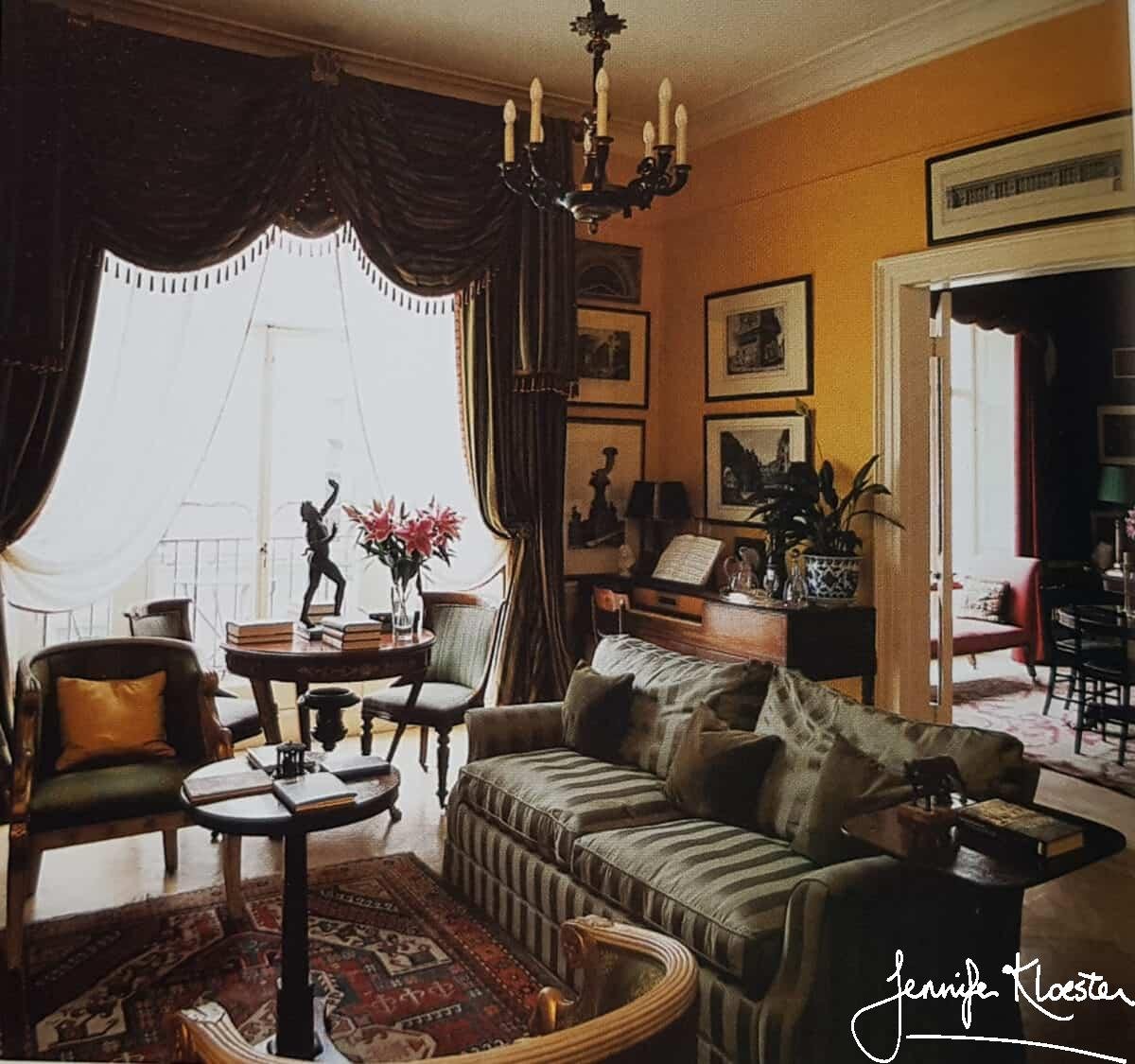
Known as “Albany”
Originally built in 1771 for the 1st Lord Melbourne as Melbourne House, in 1791 the Melbournes sold the mansion that became Albany to the Duke of York and Albany for £23,570. The Duke also assigned to Lord Melbourne the lease on Dover House in Whitehall. A decade later, mounting debts forced the Duke to sell the mansion and by 1803 it had been adapted into apartments to be known as “Albany”. The developer, Alexander Copland, converted the original mansion house into thirteen sets and built another 54 apartments in two long parallel buildings facing each other in what had been the Italian garden. Designed for “men of rank and wealth”, the Trustees established a set of rules which stipulated that “in order to exclude improper Inhabitants” the apartments could not be let or sold without the Trustees’ consent. Nor could any “Profession, Trade or Business” be conducted without the Trustees’ majority approval. Two hundred years later these same conditions still apply, for the the aim of the Trustees has been to maintain Albany’s longstanding tradition ‘as a discreet bastion of the Establishment and as a refuge for the unconventional. From its inception in 1803 as bachelor quarters, Albany had been a much sought-after address. It is a unique haven in the heart of London and, as one long-established resident put it, ‘People come to live in Albany to disappear.’ It would exactly suit Georgette Heyer.
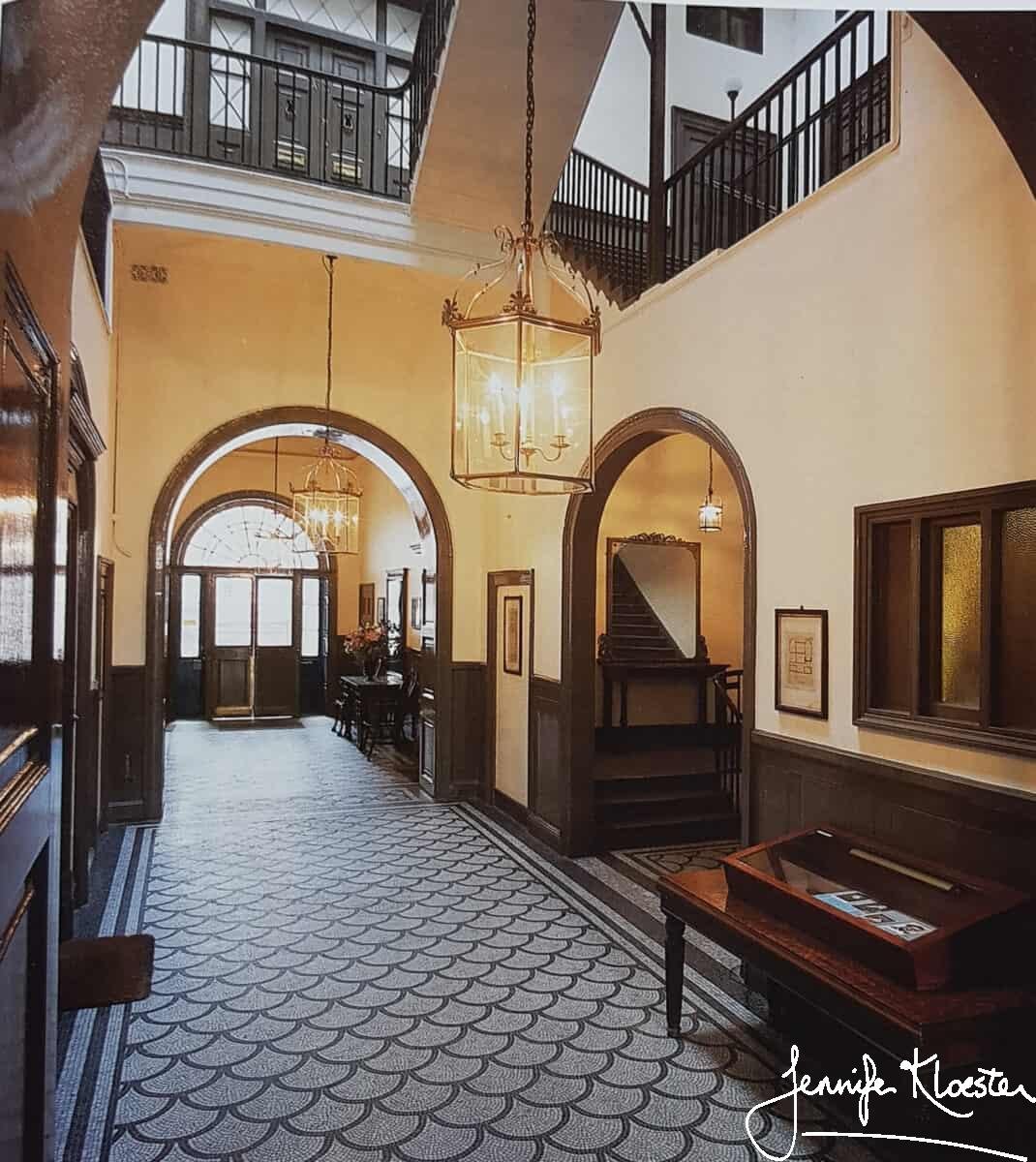
A tranquil oasis
Since its inception Albany has been home to London’s literati, theatre people, politicians, peers of the realm and those wanting a secluded but beautiful place to live in the heart of the city. Located on Piccadilly and set well back from the road with a cobblestone courtyard and a porters’ office at the front of the building, residents were assured of complete privacy. Contrary to popular myth, there has never been any rule against women living in Albany and they have done so since the 1880s. Once past the porters’ lodge, residents and approved visitors passed through an elegant entrance hall before entering the famous Rope Walk between the two “ranges of apartments” facing each other across this covered walkway. The sets in these two buildings branch off from a series of staircases lettered B to F on the west side and G to L on the east. The set in which Georgette and Ronald would eventually reside was on the F staircase and up a flight of 70 steep concrete steps. Albany was (and still is) a tranquil oasis in the heart of London which had the added benefit of being across the road from Georgette’s favourite grocers, Fortnum & Mason, and her favourite bookshop, Hatchard’s. It is no wonder that Georgette fell in love with Albany.
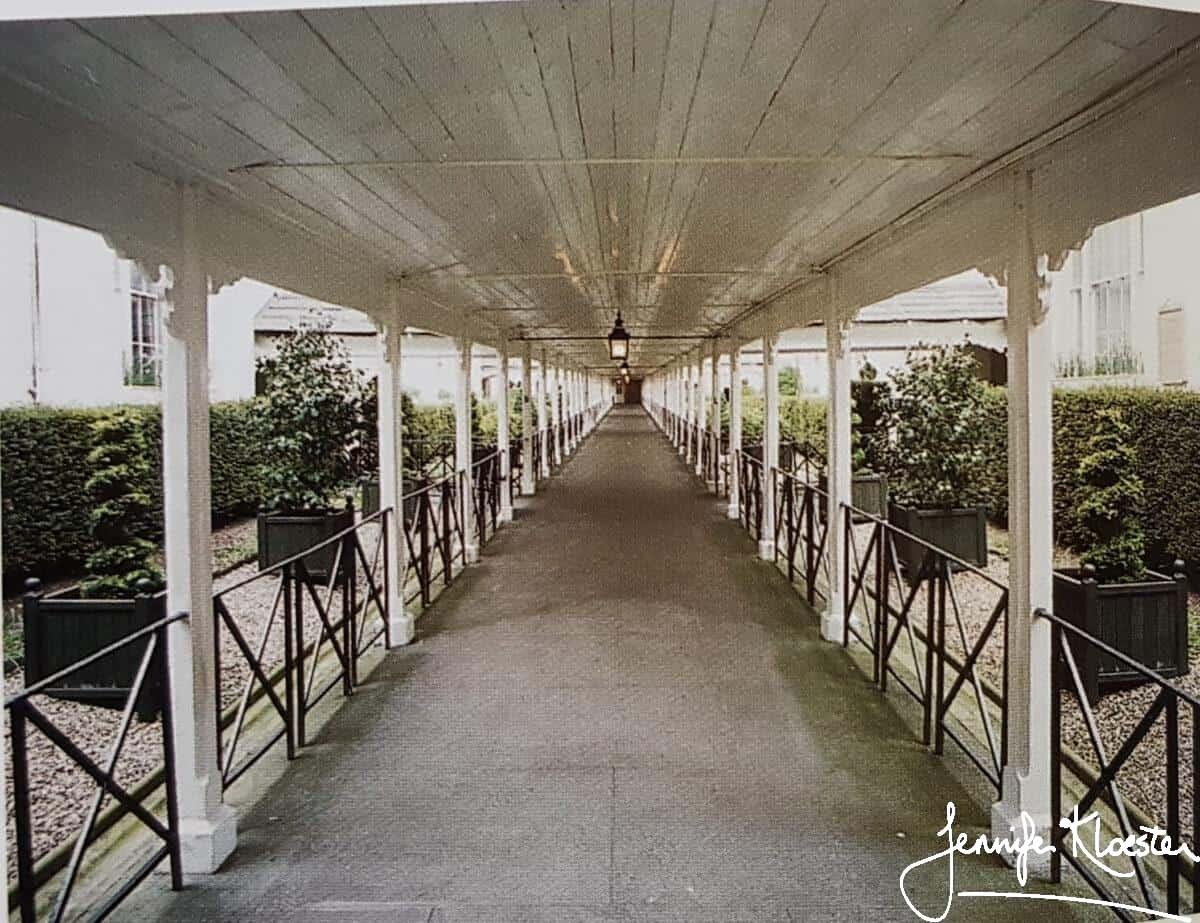
“the most superb sitting-room”
Georgette was excited by the prospect of Albany and all that it offered. The first set that she and Ronald saw was A.11 which she described as having “the most superb sitting-room, panelled in old pine, with a huge bow window'”. She told her agent that it was a set we “definitely want”, but “whether we get it or not is another matter”. She longed to move in but there were several things to work out first. Acquiring chambers in Albany could be a complicated business and Georgette’s vision for A.11 meant alterations which required a builder’s permit for a new kitchen. The War, however, made renovating very difficult and in the end Georgette had to give up the idea of A.11 and look at a different set instead. On 2 October 1942 she again wrote to Moore, this time with more positive news:
“We are definitely negotiating for a set of chambers in Albany – F.3. This is a very large set, up two long flights of concrete stairs, – rather unfortunately, having one frontage onto Vigo Street. One window only gives onto Albany itself. But it has distinct advantages – & the set I very much wanted can’t have a kitchen put in until after the War, so that was out. I may yet end up there — if I make my fortune with Penhallow!
Georgette Heyer to L.P. Moore, letter, 2 October 1942.
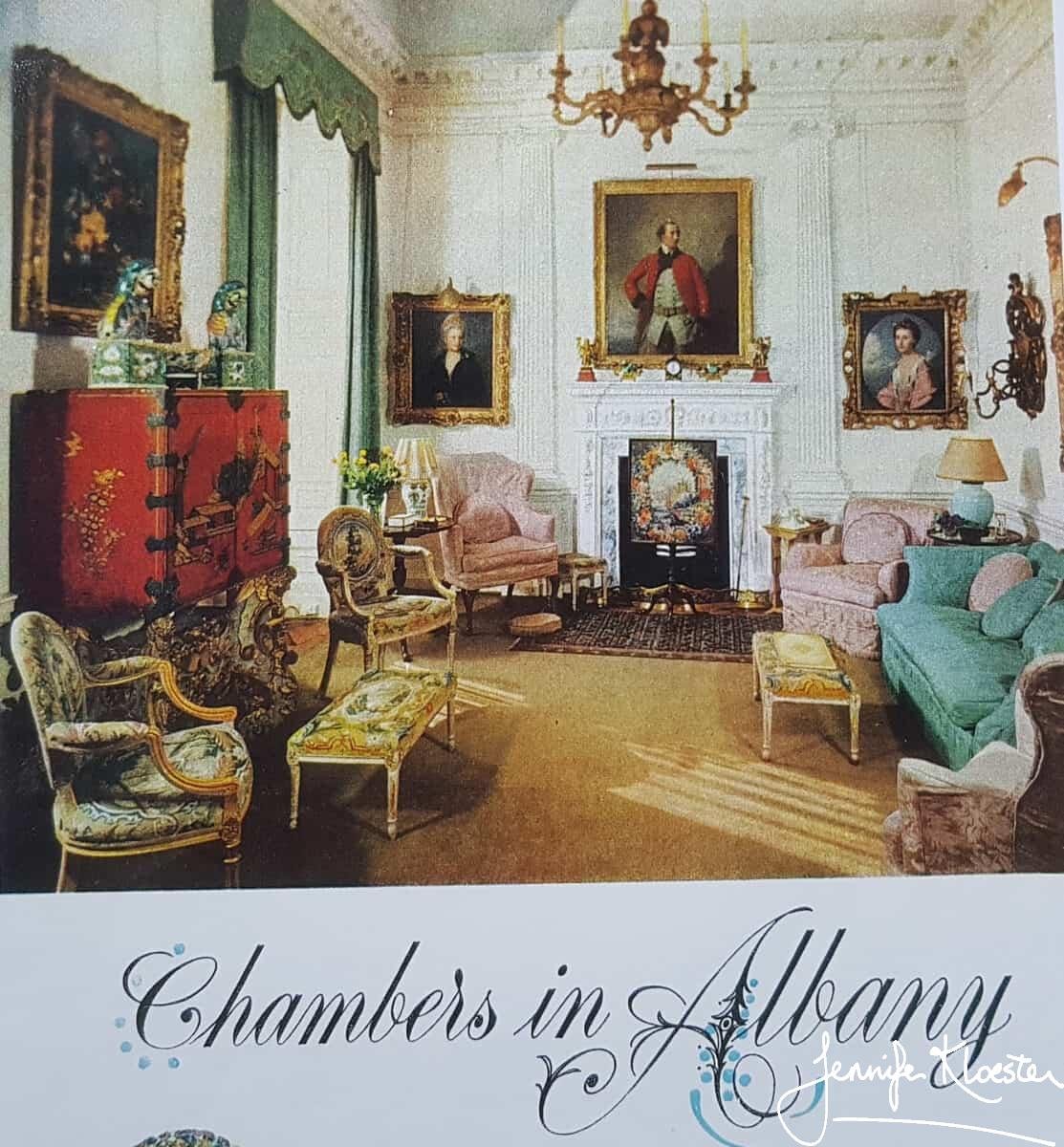
Lady Lee’s sitting-room in Albany 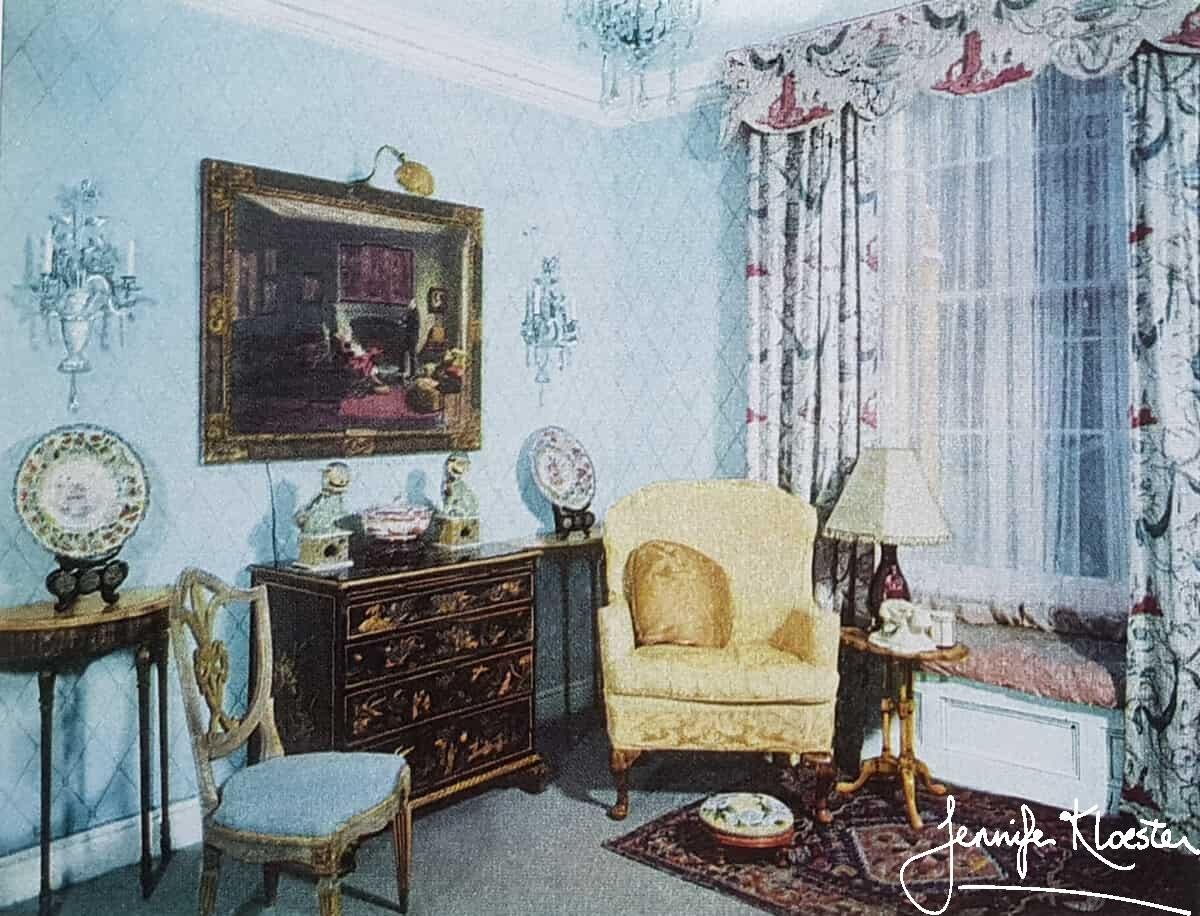
A corner of Lady Lee’s bedroom in Albany
£125 per annum!
On 24 November 1942, Georgette and Ronald moved into their new home at F.3 Albany. Located on the second floor, their new home had two floors with two main rooms and a bedroom and bathroom on the lower floor and the kitchen on the upper floor. Georgette had her desk and her library set up in the large light-filled sitting room and they ate their meals in the elegant dining room. To reach the kitchen Georgette and Ronald had to navigate a narrow winding staircase – an inconvenience they were prepared to endure if it meant living in Albany. There were also the seventy narrow concrete steps to climb in order to reach their front door but Georgette would manage these for the next 24 years, until ill-health forced her to give up her beloved set. There was so much to love about their new home, not least of which was the remarkably low rent. In 1942 this was a paltry £125 a year! This increased in 1945 to £350 per year and in 1952 until they moved out in 1966, their rent was just £500 per year!
Richard’s room
When, in 1942, Georgette and Ronald took the lease for F.3. they also took a lease on a room known as F.1 Attic. Located on the top floor and also known as “F.1 Top” this was a tiny room with a sloping roof and one window that looked out over one end of the Rope Walk and at an angle over Savile Row and Vigo Street. Richard was ten when his parents moved into Albany and, as children under the age of thirteen were not allowed to live in Albany, he had to be given a special dispensation to stay there during the school holidays. It was a lonely place for a child, and for much of his time there, Richard was the only child in residence. He had one confidant in Albany, however, and that was the remarkable man known as the Squire of Piccadilly. William Stone, was a bachelor, a lifelong Albany resident and had been “a bright young dog of the Victorian Age”. Stone owned many of Albany’s sets and when he died in 1958 he willed 37 of these to his alma mater, Peterhouse, Cambridge. Richard liked William Stone and always remembered the time when the old gentleman had bent down and said, “I was at the Tsar’s wedding you know – not the late Tsar you understand.” Richard was always fascinated that he had had as a friend a man who had been present when Maria Federovna married Alexander III.

Macaulay’s ghost and other famous residents
Many famous people have lived in Albany but its most famous ghost was the historian, Thomas Babbington Macaulay, who moved into Albany in 1840. He originally lived in E.1. where Georgette’s friends the Freres lived, but on 17 December 1846 Macaulay moved to ‘larger chambers at F.3. on the second floor by the gate which leads to Vigo Street’. Here, in the very set which Georgette Heyer would occupy almost one hundred years later, he found ‘more room for his constantly increasing library’ and wrote much of his most famous work: The History of England from the Accession of James the Second. It was in F.3 that his ghost apparently took up residence although Georgette always said that only Johnny the bull-terrier ever took any notice of it! In Georgette’s time other famous residents of Albany included Malcolm Muggeridge, Sir Isaiah Berlin, Alan Pryce-Jones, Sidney Bernstein, Antony Armstrong-Jones, Earl of Huntingdon, J.B. Priestley, Sir Kenneth Clark, Margery Sharp, Sir Harold Nicolson, Prince Littler, Viscount Esher, Graham Greene, G.B. Stern, Clifford Bax, Baron Philippe de Rothschild, Edward Heath, Sir Terence Rattigan (who moved into F2 below the Rougiers in 1946 until 1949) giving way to Clifford Bax in 1949 who in turn gave way to Ted Heath in 1962), Margaret Leighton, Edgar Lustgarten, Patrick Hamilton and Dame Edith Evans. Georgette was not fond of the Edward Heath, the future Prime Minister, because he used to play the piano late at night and keep her awake!

Albany in fiction
Albany has long been popular with authors wanting the ideal residence for their characters. From Lord Lufton in Trollope’s Framley Parsonage to Disraeli’s Endymion, Oscar Wilde’s Ernest, E.W. Hornung’s gentleman burglar, Raffles, Compton Mackenzie’s soldier bachelor, Prescott, to Georgette Heyer’s Captain Gideon Ware, all have lived in Albany and enjoyed its unique character.
“I live in the Albany,” said Endymion. “You live in the Albany!” repeated St Barbe, with an amazed and perturbed expression. “I knew I could not be a knight of the garter, or a member of White’s – the only two things and Englishman cannot command; but I did think I might some day live in the Albany. It was my dream. And you live there! Gracious!”
Benjamin Disraeli, Endymion, 1880, chapter 51.
“… and the Duke going off to Albany, where Captain Ware rented a set of chambers. These were on the first floor of one of the new buildings, and were reached by a flight of stone stairs. The Duke ran up these, and knocked on his cousin’s door … [Wragby] would have announced him had not Gilly shaken his head, and walked without ceremony into his cousin’s sitting-room. This was a comfortable square apartment, with windows giving on to a little balcony, and some folding doors that led into Captain Ware’s bedchamber. It was lit by candles, a fire burned in the grate, and the atmosphere was rather thick with cigar-smoke. The furniture was none of it very new, or very elegant, and the room was not distinguished by its neatness.
Georgette Heyer, The Foundling, Pan edition, 1967, p.60.
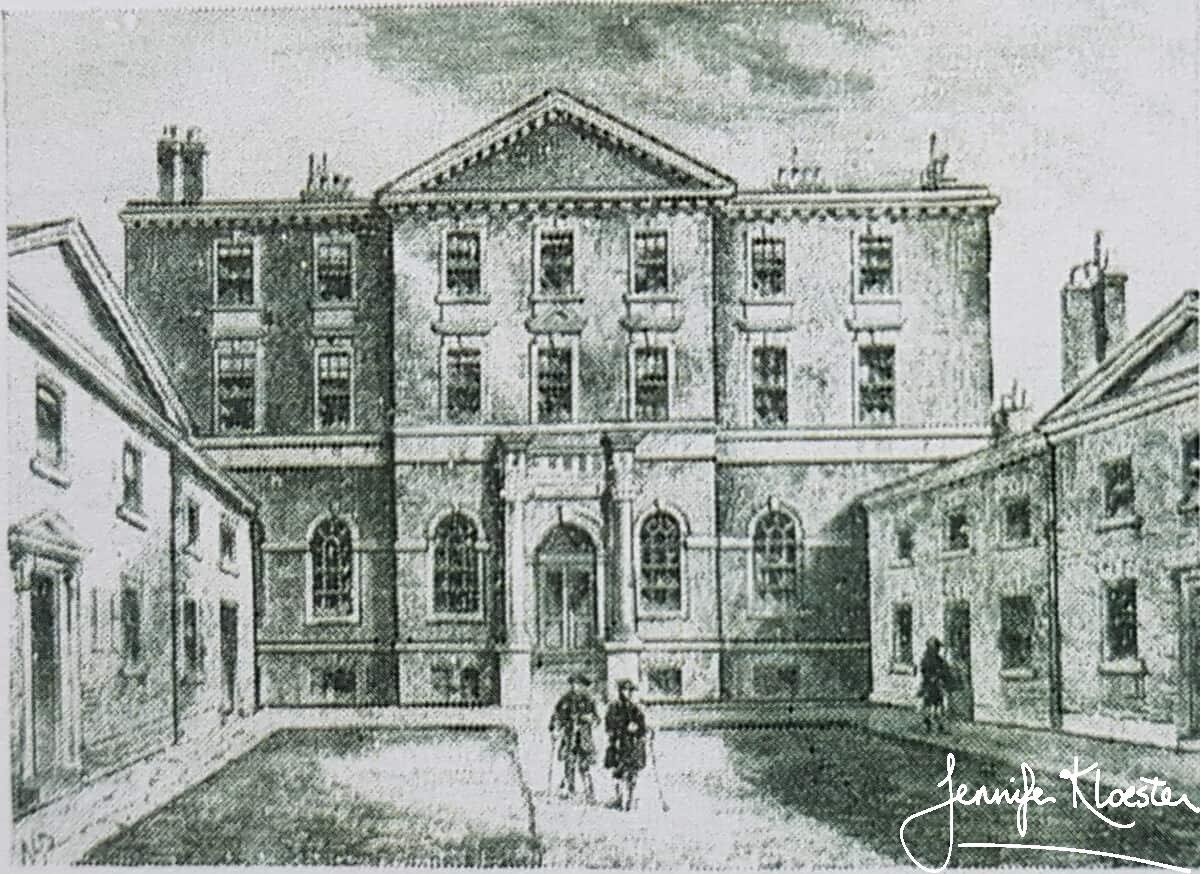



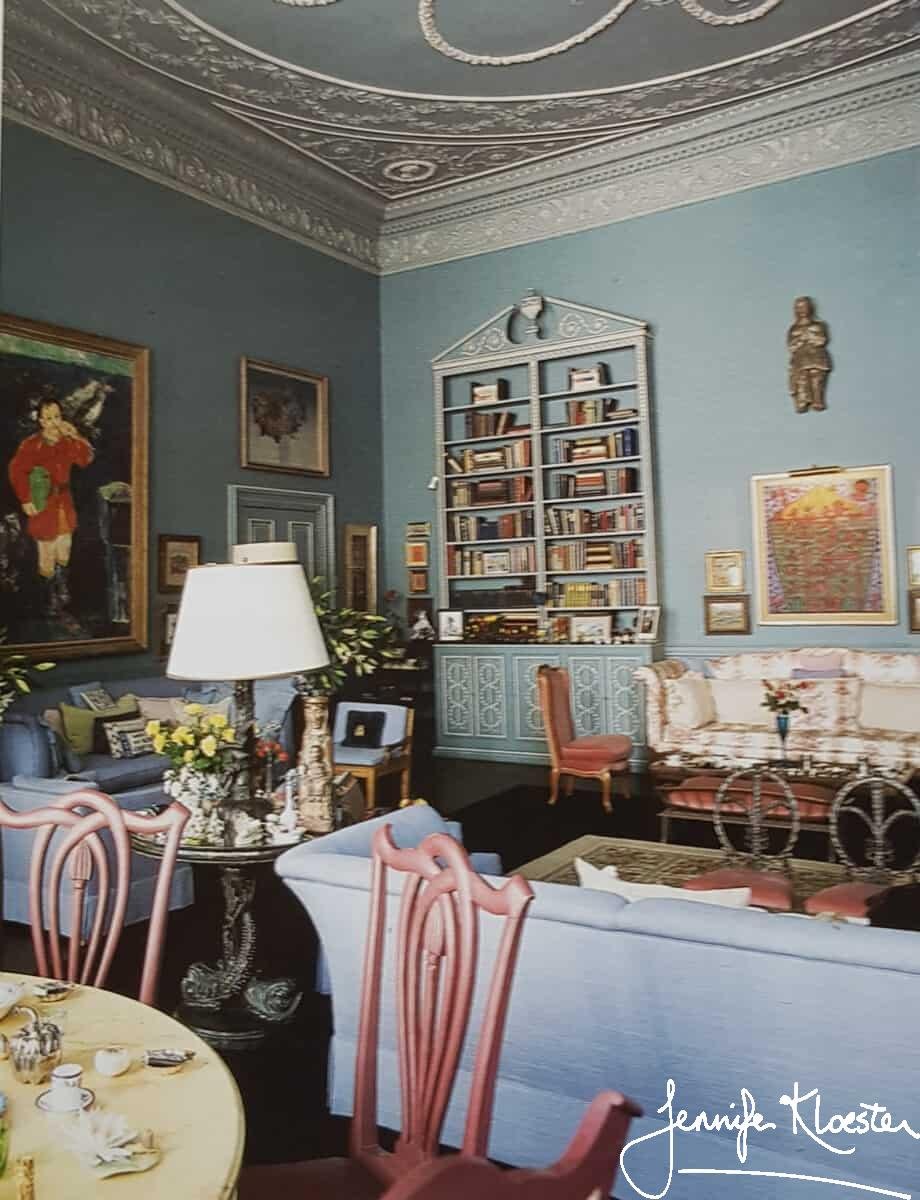
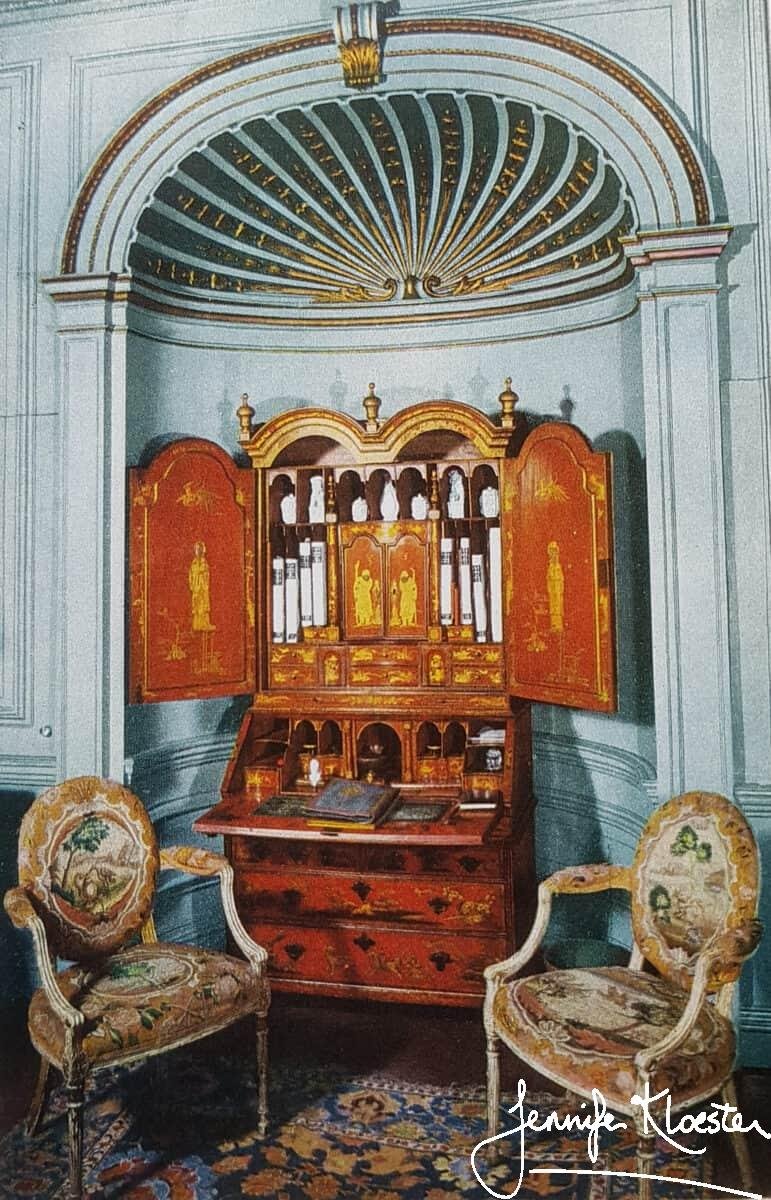


3 thoughts on “Albany – Georgette’s ideal home”
What a fascinating piece of history of this property and its’ literary and other associations. Read like a ‘who’s who’ of people I ‘should’ know. And of course puts both Ms Heyer and her family and one of her creations in this elegant long term home of hers. Thank you Jennifer.
Thank you, Sharman. It is such an interesting piece of her past, isn’t it? I loved seeing her set in Albany and imagining her writing so many of her wonderful novels there. It must have been an amazing place to live constantly running into the other creative residents!
Thank you for the picture of the entry hall. Would there have been any other common areas in use during the Regency period or when it first opens for bachelor rentals? Thanks! (P.S. — LOVED your book Georgette Heyer’s Regency World. I recommend it to everyone who wants to write about the Regency.)